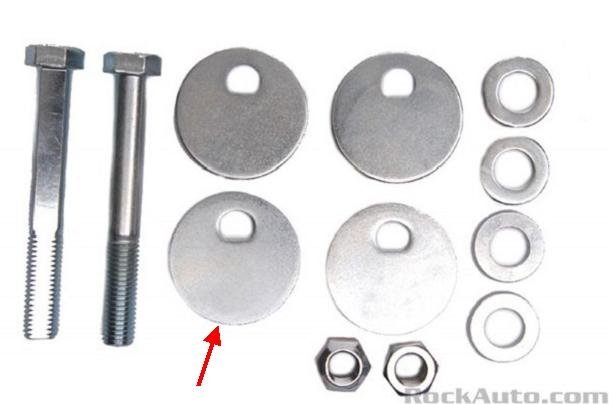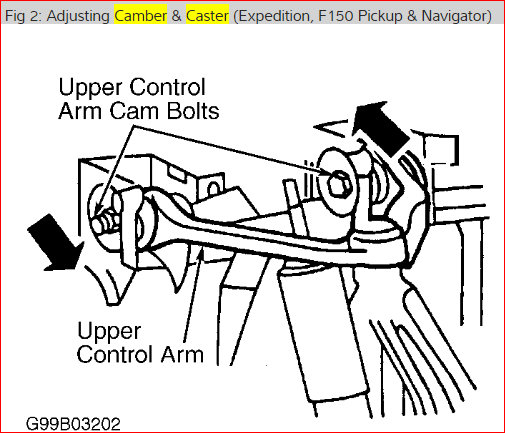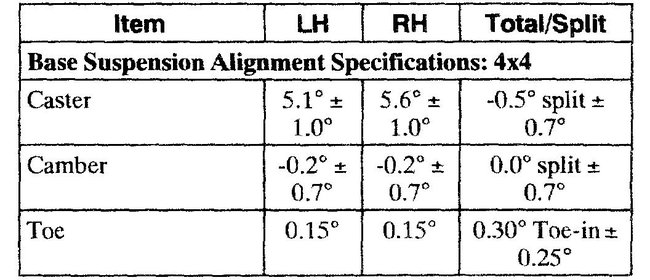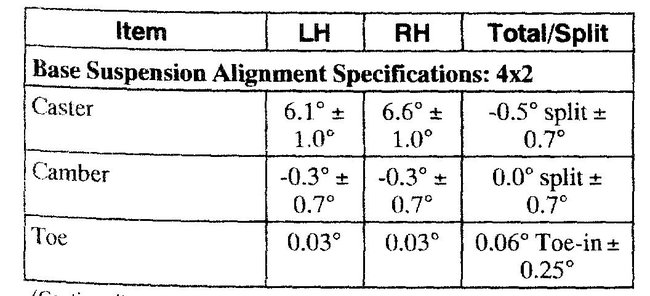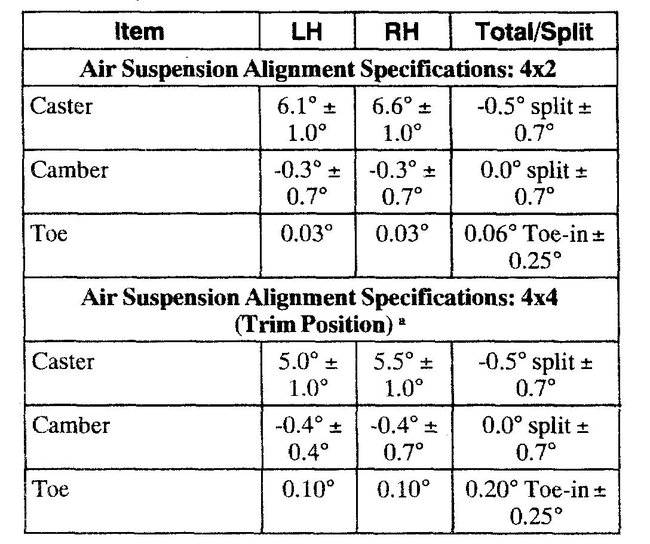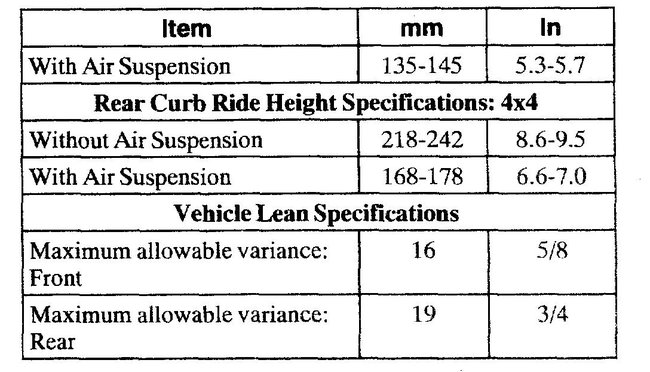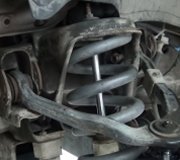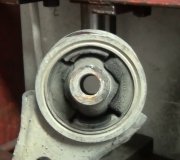Are you asking what the alignment specs are? There is actually three things your mechanic is concerned about. The first is torque specs. That has to do with how tight nuts and bolts are tightened. Some fasteners are tightened with common sense, but in steering and suspension systems, most are tightened with a special "torque wrench". It simply clicks when the fastener is tightened to the spec the wrench is adjusted to.
Next, all alignment specialists are very worried about correct ride height. Coil springs sag with age, and that changes the geometric angles of the suspension parts. Those parts hold the wheels in perfect alignment and they move through designed-in angle changes as the vehicle bounces up and down as it goes down the road. When the springs are sagged, all those geometric angles change. It is usually still possible to readjust the wheels to get them back to alignment specs, but it is critical to understand those numbers only apply to a vehicle that is standing still, not to one that is moving around while driving. The angle changes that occur while driving are designed to reduce tire wear to a minimum, but all that careful design goes out the window when ride height is wrong. Ford trucks are already very well-known for having poor tire wear, so maintaining correct ride height becomes even more critical. Some models use torsion bars, especially more so on four-wheel-drive trucks. Torsion bars are adjustable, so getting ride height back into specs is the first thing the alignment specialist will do before he starts adjusting the wheels. Other vehicles use coil springs. Those must be replaced when they become weak and sagged.
The alignment specs are built into every alignment computer, and they match what has been specified by the vehicle manufacturer. With older alignment equipment, we had to take readings, then check if they were acceptable or if we had to readjust something. We still do that with modern alignment computers, but on most of them, they will display the current readings in red if they are out-of-specs, and green if they are in-specs. Only inexperienced mechanics just adjust something until the number is green. Conscientious alignment specialists go beyond that and try to get every number perfect.
The alignment specs are different between a truck with air suspension and one with regular springs. Your mechanic will enter the information asked for, then the computer will bring up the correct set of specs. For a vehicle with regular springs, the first alignment angle is called "camber". That is the easiest one to understand. If you stand in front of the vehicle and look back at a wheel, camber refers to how much it leans in or out on top. Perfectly straight up and down is 0.00 degrees. If you could imagine a wheel tipped out so far on top that it was laying flat on the ground, that would be 90.00 degrees. Most vehicles call for around 0.25 to 0.75 degrees. The positive numbers means that wheel is tipped out on top. If that wheel is tipped out too far, that one tire will wear faster on the outer edge.
There's two important points to remember about camber. First, if that is out-of-adjustment on a wheel, it adversely affects tire wear on only that one tire, not any others. Camber can be wrong on both front wheels, as commonly happens when ride height is wrong, but each wheel's setting only affects each wheel individually. I'll add some confusion to that in a minute. The second point is a tire tends to want to roll in the direction it is leaning. We look for two things here. Besides being in specs, camber must be nearly equal on both front wheels. That makes their individual pulls to one side offset each other, and the vehicle should go straight. Next, we need to modify that slightly to make the left tire pull to the left slightly harder than the right tire wants to pull to the right. That resulting left-hand pull is needed to offset "road crown". That is where all roads slant to the right a little so water runs off. Without adjusting in a little camber pull to the left, the vehicles would drift toward the right ditch and would make for a tiring vehicle to drive.
Most Ford vehicles call for rather unusual alignment specs to reduce uneven tire wear caused by the suspension system designs. Without air suspension, yours calls for -0.2 degrees. The minus means the wheels are tipped in on top. Also be aware we can set up our alignment computers to read one or two places after the decimal point. I always set mine for two places to get more accuracy. Getting settings perfect this way takes a lot longer, but I was lucky to work for a new-car dealer where I never once get yelled at for working too slowly. Some mechanics set their computers to read to just one decimal place. That makes the job go faster but you won't get the accuracy. This is what you'll typically find at franchise tire stores where they don't have an emotional involvement with any particular car brand. At the dealerships, we put more emphasis on your satisfaction, so we don't mind taking a little longer.
Most car manufacturers also list their alignment specs to two decimal places, even when it is 0.30 or 0.40 degrees, for example. The second decimal place implies they want the greater accuracy, so while it is rather easy to get an adjustment wrestled to 0.3 degrees, it takes longer to get it to 0.30 degrees.
"Caster" is the hardest to explain and understand of the three main alignment angles. I used to tell my students there were five ways to explain it, and I would do a different description each day of the week. It never took more than Thursday's explanation for everyone to understand it. Basically, every front wheel rotates on two points to allow it to be steered to either side. One of those pivot points is always the lower ball joint. The upper pivot is usually an upper ball joint on trucks, and older cars from the '70s and before. It is commonly the upper strut mount on lightweight front-wheel-drive cars. When you stand to the side of the vehicle and look at the wheel, that upper ball joint or strut mount is further rearward than the lower ball joint. This is easier to see when you look at the angle the fork of a bicycle sits at. The fork tilts rearward as it goes up to the handlebars. When you put weight on the bicycle, that angle is what allows you to ride no-handed. On a car, when you put the car's weight on the front wheels, this "positive caster" makes the left wheel turn fully to the right so hard you probably can't pull it back by hand. It also makes the right wheel tug fully to the left just as hard. It's when you connect them together with the steering linkage that they balance out and offset each other, and the vehicle goes straight.
One of the designed-in characteristics of caster is it causes a wheel to tip out on top when it is turned out. To say that a better way, when you turn the steering wheel to the left, the left wheel and tire will tip out more on top, and the right one will tip in on top. Caster can not be measured directly with any alignment equipment. We need to turn the steering wheel to the left a specified amount, then the alignment computer takes a camber reading. Next, we turn the steering wheel to the right the specified amount, then the computer takes a second camber reading. It uses those two camber readings to calculate and display caster. It always does that for both front wheels at the same time. Where this gets real time-consuming is those caster numbers on the screen only update after we make adjustments, then perform another "caster swing". There is a screen that shows us how caster is changing as we adjust something, but that feature is only approximate; when we think it is right, we have to do another caster swing to update and display the accurate readings.
Getting caster set right is not real difficult. What takes so much time is getting it to match on both wheels. With the design of your suspension system, there are two things to move on each wheel, and they both change camber and caster. It's their interaction that makes the job take so long.
Caster can also be used to offset road crown. Caster on the right side can be adjusted a little higher than on the left side. That makes the right wheel want to turn left a little harder than the left wheel wants to turn right. As a point of interest, it takes twice the difference in caster to offset road crown as it does for camber. In other words, we might like to see -0.2 degrees camber on your left front, and -0.3 degrees on the right front, to offset road crown. Instead, if we leave them both exactly equal, we could aim for 3.0 degrees caster on the left front, then it would take 3.2 degrees on the right to offset road crown. There was 0.1 degree camber difference, but instead, 0.2 degrees caster difference would accomplish the same thing.
3.00 degrees caster is a real common value since the mid '60s. Before that it was common to find negative caster, meaning the upper ball joint was further ahead of the lower ball joint. That made turning the steering wheel real easy on large trucks and heavy cars. By the '60s we were driving faster, and one undesirable characteristic of negative caster showed up. That was excessive, irritating steering wander. The constant correcting made for a very tiring car to drive. Moving to positive caster like all vehicles use today greatly increases steering stability, and is why you can go for many miles with just one finger on the steering wheel. The big drawback to this positive caster is it makes turning the steering wheel very difficult, basically because doing so causes a corner of the car to rise up. You're lifting the vehicle now when you turn to one side. The engineers added power steering to overcome that high steering effort. That's why you'll see power steering on all vehicles now.
Once the mechanic is satisfied with the camber and caster adjustments, the final step is to lock the steering wheel perfectly straight ahead, then he adjusts each front wheel to be pointed straight ahead. On one wheel that is called the "toe" adjustment. When both wheels are looked at together, it is called the "total toe" adjustment. This is where I promised to add some confusion when discussing tire wear. Remember that camber on one front wheel only affects accelerated wear on the inner or outer edge of just that one tire. Total toe always affects both tires equally. If, for example, you start with a car that is in perfect alignment, then misadjust left front toe to make that wheel steer too much toward the center of the car, that will make the car tend to go toward the right ditch. You have to counteract that by turning the steering wheel to the left. Doing so brings the left wheel only halfway back to where it should be, and it brings the right wheel in an equal amount. The pair of tires would look like a V-type snowplow going down the road. If you exaggerate this for clarity, and turn the left wheel to the right more and more until it is sideways, you can see the outer side wall is in front and is the first part of the tire coming down the road. That is called the "leading edge", and is the part that is going to scrub off. You can see this if you hold a pencil straight up with the eraser on the table. Push down, then slide the eraser across the table, and you'll see the leading edge scrubs off, making eraser crumbs, and the trailing edge bends and lifts up off the table. No wear takes place on the trailing edge. The same thing happens on the tires, but always to both of them equally.
Now to really confuse the issue, what if toe is wrong on both front wheels? When it's wrong on only one wheel, you have to turn the steering wheel so toe will be wrong an equal amount on both sides so the car goes straight down the road. The symptom is the steering wheel will be off-center. Toe can be off one way on one wheel and an equal amount the other way on the other wheel, which can make total toe perfect, with no tire wear, but the steering wheel will be off-center. You can also have toe off equally on both wheels so the steering wheel is still nice and straight, but the tires will be scrubbing off badly. The most noticeable symptom of incorrect total toe is excessive steering wander. The car will want to follow the tire with the most weight on it, which is usually the right one, but when you hit an intersection or a bump in the road, it might follow the left tire momentarily. Since the two tires are steering in different directions, and the tire being followed keeps changing, you have to be constantly correcting the direction of travel. That can be very tiring.
There are other secondary alignment angles that we usually don't need to look at unless we're checking for crash damage, but they show up on the alignment computer automatically. All computers have the ability to make a printout of the alignment. There will be a column of "Before" measurements, meaning before anything was changed by the mechanic, and the "After" readings which are the final specs when all adjustments were completed. I always put a copy on the passenger front seat with the things highlighted that I changed. Ask to receive a copy since many mechanics don't bother with that. I can interpret the numbers for you.
I know that's more wondrous information than you wanted, so to boil it down, here are the alignment specs for your truck with the standard suspension system:
Camber: -0.2 plus or minus 0.7 degrees
Cross Camber: 0.0 plus or minus 0.7 degrees
Caster, Left: 5.1 plus or minus 1.0 degrees
Caster, Right: 5.6 plus or minus 1.0 degrees
Cross Caster: -0.5 plus or minus 0.7 degrees
Toe: 0.15 degrees each wheel
Total toe: 0.30 plus or minus 0.25 degrees
As a specialist, these numbers remind me of a baby giraffe trying to stand up for the first time. No conscientious alignment mechanic will let your truck go with these numbers. "Cross camber" is the difference from side to side, and the engineers are saying it is okay to have a 0.7 degree pull either way. That is a lot and is sure to result in a complaint. Your arms will become tired holding onto the steering wheel. Most alignment computers offer one shot at reducing the tolerances to force us to go for more accuracy. Doing so here would likely change that 0.7 degrees to 0.3 degrees.
The five degrees caster is about double of what the majority of cars and light trucks call for. Excessive caster adds road feel to the steering wheel, meaning, in part, you'll feel every bump more than before in the steering wheel. Softer rubber bushings and other design factors can reduce the objectionable aspects of road feel so much that they can increase caster to get better stability without sacrificing ride quality.
The engineers are requesting to use cross caster of -0.5 degrees to offset road crown. That seems a little high, but it's important to note all of these numbers can leave you with an unsatisfactory alignment. When they don't bother to go to two decimal places in their specs, and they allow such a wide range of values they consider "acceptable, it is important to understand that these are for warranty purposes only. If you bring the vehicle in under warranty with a handling or tire wear complaint, Ford will not pay for an alignment if the numbers all fall within these limits. My friend who works for the local Ford dealer will open a door, deflate a tire, or simply lean on the vehicle to force the numbers on the computer screen to turn red, then Ford will pay for the alignment and he can do whatever it takes to solve your legitimate complaint. Some dealership mechanics are not so benevolent. The vehicle is still under warranty, but they don't mind letting you pay for the alignment.
For one final note of value, it takes twice as many degrees of caster difference to offset a difference in camber, so if the best the mechanic can get is a 0.1 degree camber pull to the right, he may be satisfied if he also has a 0.2 degrees caster pull to the left. That would make the vehicle go straight on a flat road, but it still needs to have something adjusted to offset road crown.
Also, all this discussion about caster does not pertain to front-wheel-drive cars. Those cars seem to be immune to caster that is even wildly different from side-to-side. In fact, there are very few front-wheel-drive cars that even have a means of adjusting caster. I've had cars with as much as 3.00 degrees difference, and they still went straight. Three degrees is dandy for a circle-track race car to make it turn left without the driver having to do much. His effort goes into tugging the steering wheel straight. You wouldn't want to drive a car on the highway more than a mile or two with that much caster difference.
Images (Click to make bigger)
Sunday, December 9th, 2018 AT 10:38 PM
